Subduction Dynamics of the Paleo-Pacific Plate: New Constraints from Quartz Diorites in the Fudong Region
Abstract
1. Introduction

2. Geological Background and Petrology
2.1. Regional Geological Setting
2.2. Lithological Characteristics of Fudong Quartz Diorite
3. Analytical Methods
3.1. Zircon U-Pb Dating
3.2. Major and Trace Element Determinations
3.3. Whole-Rock Sr-Nd Isotopic Analyses
3.4. Zircon Hf Isotopic Analyses
4. Analytical Results
4.1. Zircon U-Pb Age
4.2. Major and Trace Elements
4.3. Whole-Rock Sr-Nd Isotopes
4.4. Zircon Hf Isotopes
5. Discussion
5.1. Petrogenesis and Magma Source
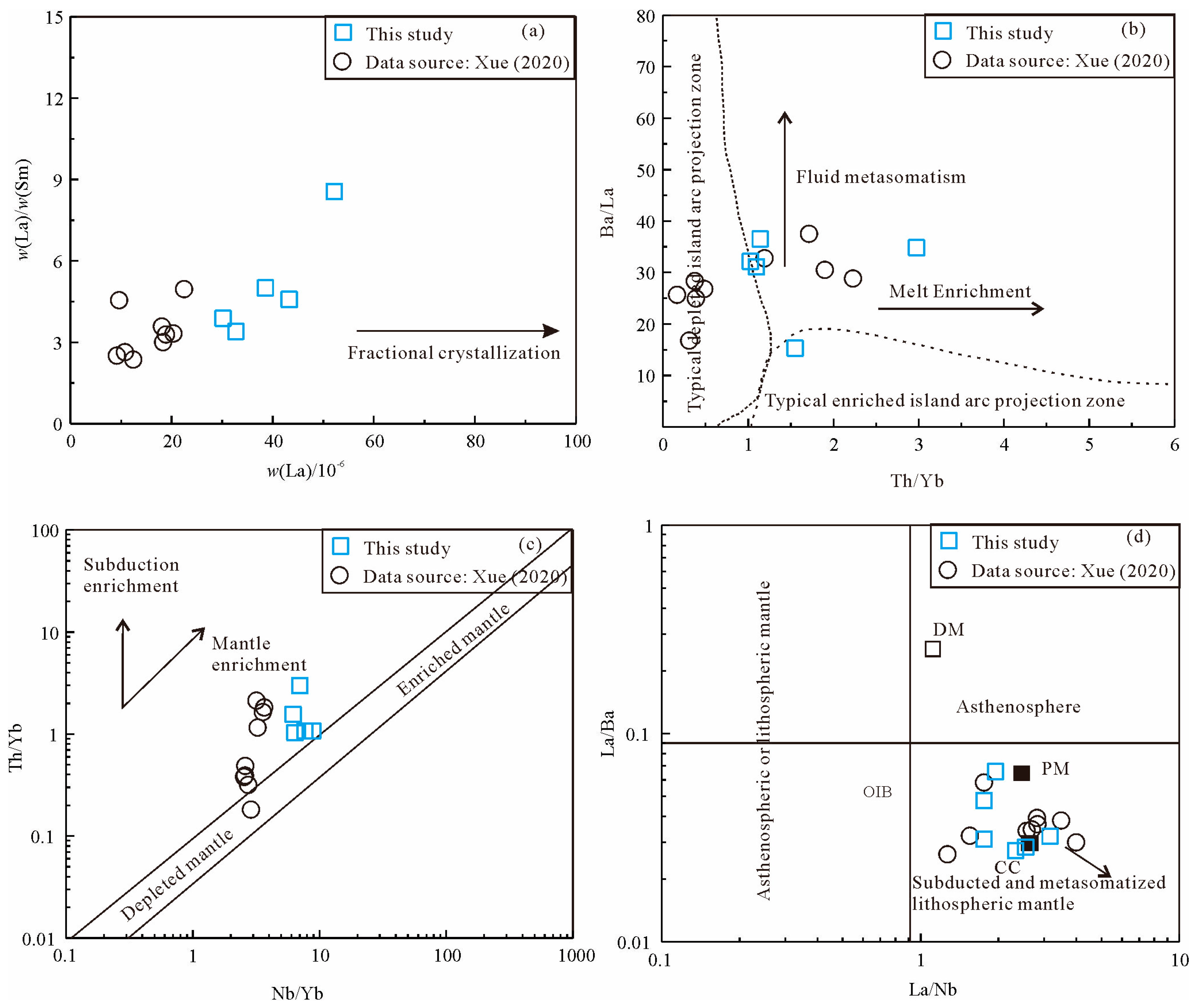

5.2. Tectonic Implications of Fudong Quartz Diorite
6. Conclusions
Supplementary Materials
Author Contributions
Funding
Data Availability Statement
Acknowledgments
Conflicts of Interest
References
- Şengör, A.C.; Natal’in, B.A.; Sunal, G.; van der Voo, R. The tectonics of the Altaids: Crustal growth during the construction of the continental lithosphere of Central Asia between ~750 and ~130 Ma ago. Annu. Rev. Earth Planet. Sci. 2018, 46, 439–494. [Google Scholar] [CrossRef]
- Kröner, A.; Windley, B.F.; Badarch, G.; Tomurtogoo, O.; Hegner, E.; Jahn, B.M.; Gruschka, S.; Khain, E.V.; Demoux, A.; Wingate, M.T.D.; et al. Accretionary Growth and Crust-formation in the Central Asian Orogenic Belt and Comparison with the Arabian-Nubian Shield. In The 4-D Framework of the Continental Crust—Integrating Crustal Processes Through Time; Geological Society of America Memoir; Geological Society of America: Boulder, CO, USA, 2007; Volume 200, pp. 181–209. [Google Scholar]
- Xiao, W.; Sun, M.; Santosh, M. Continental Reconstruction and Metallogeny of the Circum-Junggar Areas and Termination of the Southern Central Asian Orogenic Belt. Geosci. Front. 2015, 6, 137–140. [Google Scholar] [CrossRef]
- Guo, F.; Huan, M.W.; Zhao, L. Nd-Hf-O Isotopic Evidence for Subduction-induced Crustal Replacement in NE China. J. Chem. Geol. 2019, 525, 125–142. [Google Scholar] [CrossRef]
- Shi, Y.; Shi, S.; Liu, Z.H.; Wang, L.; Liu, J.; Chen, J.S.; Yang, F.; Zhang, C.; Li, B.; Zhang, L.D. Back-arc System Formation and Extinction in the Southern Central Asian Orogenic Belt: New Constraints from the Faku Ophiolite in North Liaoning, NE China. Gondwana Res. 2022, 103, 64–83. [Google Scholar] [CrossRef]
- Li, J.Y. Permian geodynamic setting of Northeast China and adjacent regions: Closure of the Paleo–Asian Ocean and subduction of the Paleo–Pacific Plate. J. Asian Earth Sci. 2006, 26, 207–224. [Google Scholar] [CrossRef]
- Wu, F.Y.; Sun, D.Y.; Ge, W.C.; Zhang, Y.B.; Grant, M.L.; Wilde, S.A.; Jahn, B.M. Geochronology of the Phanerozoic granitoids in Northeastern China. J. Asian Earth Sci 2011, 41, 1–30. [Google Scholar] [CrossRef]
- Li, Y.; Xu, W.L.; Zhang, X.M.; Tang, J. Petrogenesis of Jurassic Granitic Plutons in the Yanbian Area, NE China: Implications for the Subduction History of the Paleo-Pacific Plate. J. Asian Earth Sci. 2024, 259, 105940. [Google Scholar] [CrossRef]
- Du, Q.X.; Li, G.S.; Han, Z.Z.; Shen, X.L. Reappraisal of Ages of Triassic Continental Sedimentary Successions in the Yanbian Area (NE China): Implications for the Triassic Angaran and Cathaysian Floral Recovery. J. Asian Earth Sci. 2021, 215, 104811. [Google Scholar] [CrossRef]
- Du, Q.X.; Han, Z.Z.; Shen, X.L.; Han, C.; Song, Z.G.; Gao, L.H.; Han, M.; Zhong, W.J. Geochronology and Geochemistry of Permo-Triassic Sandstones in Eastern Jilin Province (NE China): Implications for Final Closure of the Paleo-Asian Ocean. Geosci. Front. 2019, 10, 683–704. [Google Scholar] [CrossRef]
- Dong, Y.; Ge, W.C.; Yang, H.; Xu, W.L.; Bi, J.H.; Wang, Z.H. Geochemistry and Geochronology of the Late Permian Mafic Intrusions Along the Boundary Area of Jiamusi and Songnen-Zhangguangcai Range Massifs and Adjacent Regions, Northeastern China: Petrogenesis and Implications for the Tectonic Evolution of the Mudanjiang Ocean. Tectonophysics 2017, 694, 356–367. [Google Scholar]
- Long, X.; Xu, W.; Guo, P.; Sun, C.Y.; Luan, J.P. Was Permian Magmatism in the Eastern Songnen and Western Jiamusi Massifs, NE China, Related to the Subduction of the Mudanjiang Oceanic Plate? Geol. J. 2020, 55, 1781–1807. [Google Scholar] [CrossRef]
- Zhou, J.B.; Wilde, S.A.; Zhang, X.Z.; Zhao, J.C.; Zheng, C.Q.; Wang, Y.J.; Zhang, X.H. The onset of Pacific Margin accretion in NE China: Evidence from the Heilongjiang high-pressure metamorphic belt. Tectonophysics 2009, 478, 230–246. [Google Scholar] [CrossRef]
- Zhou, J.B.; Wilde, S.A.; Zhao, G.C.; Zhang, X.Z.; Zheng, C.Q.; Wang, H. New SHRIMP U-Pb zircon ages from the Heilongjiang High-Pressure Belt: Constraints on the Mesozoic evolution of NE China. Am. J. Sci. 2010, 310, 1024–1053. [Google Scholar] [CrossRef]
- Yu, J.J.; Wang, F.; Xu, W.L.; Gao, F.H.; Pei, F.P. Early Jurassic mafic magmatism in the Lesser Xing’an–Zhangguangcai Range, NE China, and its tectonic implications: Constraints from zircon U–Pb chronology and geochemistry. Lithos 2012, 142–143, 256–266. [Google Scholar] [CrossRef]
- Zhou, J.B.; Chen, Z. Assembly processes in the eastern Northern Orogenic Belt and implications for the spatiotemporal transition of major tectonic domains in Northeast Asia. Sci. China Earth Sci. 2023, 66, 2648–2652. [Google Scholar] [CrossRef]
- van der Meer, D.G.; Spakman, W.; van Hinsbergen, D.J.J.; Amaru, M.L.; Torsvik, T.H. Towards absolute plate motions constrained by lower-mantle slab remnants. Nat. Geosci. 2010, 3, 36–40. [Google Scholar] [CrossRef]
- Müller, R.D.; Sdrolias, M.; Gaina, C.; Roest, W.R. Age, spreading rates, and spreading asymmetry of the world’s ocean crust. Geochem. Geophys. Geosyst. 2008, 9, Q04006. [Google Scholar] [CrossRef]
- Kiminami, K.; Imaoka, T. Spatiotemporal variations of Jurassic-Cretaceous magmatism in eastern Asia (Tan-Lu Fault to SW Japan): Evidence for flat-slab subduction and slab rollback. Terra Nova 2013, 25, 414–422. [Google Scholar] [CrossRef]
- Ma, X.H.; Zhu, W.P.; Zhou, Z.H.; Qiao, S.L. Transformation from Paleo-Asian Ocean closure to Paleo-Pacific subduction: New constraints from granitoids in the eastern Jilin–Heilongjiang Belt, NE China. J. Asian Earth Sci. 2017, 144, 261–286. [Google Scholar] [CrossRef]
- Cao, H.H.; Xu, W.L.; Pei, F.P.; Zhang, X.Z. Permian tectonic evolution in southwestern Khanka Massif: Evidence from zircon U–Pb chronology, Hf isotope and geochemistry of gabbro and quartz diorite. Acta Geol. Sin. 2011, 85, 1390–1402. [Google Scholar]
- Guo, F.; Li, H.X.; Fan, W.M.; Li, J.Y.; Zhao, L.; Huang, M.W.; Xu, W.L. Early Jurassic subduction of the Paleo-Pacific Ocean in NE China: Petrologic and geochemical evidence from the Tumen mafic intrusive complex. Lithos 2015, 224–225, 46–60. [Google Scholar] [CrossRef]
- Li, J.Y.; Zhang, J.; Yang, T.N.; Li, Y.P.; Sun, G.H.; Zhu, Z.X.; Wang, L.J. Crustal tectonic division and evolution of the Southern part of the North Asian Orogenic Region and its adjacent areas. J. Jilin Univ. (Earth Sci. Ed.) 2009, 39, 584–605, (In Chinese with English abstract). [Google Scholar]
- Anderson, T. Correction of Common Lead in U-Pb Analyses That Do Not Report 204 Pb. ChemicalGeology 2002, 192, 59–79. [Google Scholar]
- Ludwig, K.R. User’s Manual for Isoplot 3.00: A Geochronological Toolkit for Microsoft Excel; Berkeley Geochronology Center: Berkeley, CA, USA, 2003. [Google Scholar]
- Geng, J.Z.; Li, H.K.; Zhang, J.; Zhou, H.Y.; Li, H.M. Zircon Hf Isotope Analysis by Means of LA-MC-ICP-MS. Geol. Bull. China 2011, 30, 1508–1513. [Google Scholar]
- Wu, F.Y.; Li, X.H.; Zheng, Y.F.; Gao, S. Lu-Hf Isotopic Systematics and their Applications in Petrology. Acta Petrol. Sin. 2007, 23, 185–220. [Google Scholar]
- Pupin, J.P. Zircon and granite petrology. Contrib. Mineral. Petrol. 1980, 73, 207–220. [Google Scholar] [CrossRef]
- Koschek, G. Origin and significance of the SEM cathodoluminescence from zircon. J. Microsc. 1993, 171, 223–232. [Google Scholar] [CrossRef]
- Irvine, T.H.; Baragar, W.R.A. A guide to the chemical classification of the common volcanic rocks. Can. J. Earth Sci. 1971, 8, 523–548. [Google Scholar] [CrossRef]
- Peccerillo, A.; Taylor, A.R. Geochemistry of Eocene calc-alkaline volcanic rocks from the Kastamonu area, Northern Turkey. Contrib. Mineral. Petrol 1976, 58, 63–81. [Google Scholar] [CrossRef]
- Maniar, P.D.; Piccoli, P.M. Tectonic discrimination of granitoids. Geol. Soc. Am. Bull. 1989, 101, 635–643. [Google Scholar] [CrossRef]
- Guo, F.; Li, H.X.; Fan, W.M.; Li, J.Y.; Zhao, L.; Huang, M.W. Variable Sediment Flux in Generation of Permian Subduction-Related Mafic Intrusions from the Yanbian Region, NE China. Lithos 2016, 261, 195–215. [Google Scholar] [CrossRef]
- Sun, M.D.; Xu, Y.G.; Wilde, S.A.; Chen, H.L.; Yang, S.F. The Permian Dongfanghong island-arc gabbro of the Wandashan Orogen, NE China: Implications for Paleo-Pacific subduction. Tectonophysics 2015, 659, 122–136. [Google Scholar] [CrossRef]
- Guo, F.; Fan, W.L.; Gao, X.F.; Li, C.W.; Miao, L.C.; Zhao, L.; Li, H.X. Sr–Nd–Pb Isotope Mapping of Mesozoic Igneous Rocks in NE China: Constraints on Tectonic Framework and Phanerozoic Crustal Growth. Lithos 2010, 120, 563–578. [Google Scholar] [CrossRef]
- Tatsumi, Y. Origin of high-magnesian andesites in the Setouchi volcanic belt, southwest Japan, II. Melting phase relations at high pressures. Earth Planet. Sci. Lett. 1982, 60, 305–317. [Google Scholar] [CrossRef]
- Grove, T.L.; Elkins-Tanton, L.T.; Parman, S.W.; Chatterjee, N.; Müntener, O.; Gaetani, G.A. Fractional crystallization and mantle-melting controls on calc-alkaline differentiation trends. Contrib. Mineral. Petrol. 2003, 145, 515–533. [Google Scholar] [CrossRef]
- Kelemen, P.B. Genesis of high Mg# andesites and the continental crust. Contrib. Mineral. Petrol. 1995, 120, 1–19. [Google Scholar]
- Jung, S.; Hoernes, S.; Mezger, K. Synorogenic melting of mafic lower crust: Constraints from geochronology, petrology and Sr, Nd, Pb and O isotope geochemistry of quartz diorites (Damara orogen, Namibia). Contrib. Mineral. Petrol. 2002, 143, 551–566. [Google Scholar] [CrossRef]
- Rogers, G.; Hawkesworth, C.J. A geochemical traverse across the North Chilean Andes: Evidence for crust generation from the mantle wedge. Earth Planet. Sci. Lett. 1989, 91, 271–285. [Google Scholar] [CrossRef]
- Allègre, C.J.; Minster, J.F. Quantitative models of trace element behavior in magmatic processes. Earth Planet. Sci. Lett. 1978, 38, 1–25. [Google Scholar] [CrossRef]
- Liu, H.N.; Li, X.W.; Mo, X.X.; Xu, J.F.; Liu, J.J.; Dong, G.C.; Shan, W.; Zhang, Y.; Wang, K.; Yu, H.X. Early Mesozoic crustal evolution in the NW segment of West Qinling, China: Evidence from diverse intermediate–felsic igneous rocks. Lithos 2021, 396, 106187. [Google Scholar] [CrossRef]
- Castro, A. Tonalite–granodiorite suites as cotectic systems: A review of experimental studies with applications to granitoid petrogenesis. Earth-Sci. Rev. 2013, 124, 68–95. [Google Scholar] [CrossRef]
- Castro, A. The off-crust origin of granite batholiths. Geosci. Front. 2014, 5, 63–75. [Google Scholar] [CrossRef]
- Pearce, J.A.; Norry, M.J. Petrogenetic implications of Ti, Zr, Y, and Nb variations in volcanic rocks. Contrib. Mineral. Petrol. 1979, 69, 33–47. [Google Scholar] [CrossRef]
- Münker, C. Nb/Ta fractionation in a Cambrian arc back arc system, New Zealand: Source Constraints and Application of refined ICPMS techniques. Chem. Geol. 1998, 144, 23–45. [Google Scholar] [CrossRef]
- Petrogenesis and paleogeographic reconstruction significance of mafic dykes in liangcheng, northern margin of the North China craton. Acta Geol. Sin. 2023, 97, 1295–1314.
- Woodhead, J.D.; Hergt, J.M.; Davidson, J.P.; Eggins, S.M. Hafnium isotope evidence for “conservative, element mobility during subduction zone processes. Earth Planet. Sci. Lett. 2001, 192, 331–346. [Google Scholar] [CrossRef]
- Pearce, J.A. Geochemical fingerprinting of oceanic basalts with applications to ophiolite classification and the search for Archean oceanic crust. Lithos 2008, 100, 14–48. [Google Scholar] [CrossRef]
- Xue, H.R. Features of the Mafic-ultramafic Rocks in Jilin Province and their Metallogenesis. Doctoral Dissertation, Jilin University, Changchun, China, 2020. [Google Scholar]
- Zindler, A.; Hart, S.R. Chemical Geodynamics. Annu. Rev. Earth Planet. Sci. 1986, 14, 493–571. [Google Scholar] [CrossRef]
- Plank, T. Constraints from thorium/lanthanum on sediment recycling at subduction zones and the evolution of the continents. J. Petrol. 2005, 46, 921–944. [Google Scholar] [CrossRef]
- Xiao, D.; Zhao, X.Y.; Liao, Q.N.; Zhao, H.; Zeng, Z. Early Palaeozoic arc-related gabbro—Diorite suite in East Junggar, southern Central Asian Orogenic Belt: Petrogenesis and tectonic implications. Int. Geol. Rev. 2020, 62, 1205–1223. [Google Scholar] [CrossRef]
- Liu, Y.J.; Li, W.M.; Feng, Z.Q.; Wen, Q.B.; Neubauer, F.; Liang, C.Y. A review of the Paleozoic tectonics in the eastern part of Central Asian Orogenic Belt. Gondwana Res. 2017, 43, 123–148. [Google Scholar] [CrossRef]
- Jahn, B.M.; Wu, F.Y.; Chen, B. Granitoids of the central Asian orogenic belt and continental growth in the Phanerozoic. Trans. R. Soc. Edinb. Earth Sci. 2000, 91, 81–93. [Google Scholar]
- Wood, D.A. The application of a Th-Hf-Ta diagram to problems of tectonomagmatic classification and to establishing the nature of crustal contamination of basaltic lavas of the British Tertiary volcanic province. Earth Planet. Sci. Lett. 1980, 50, 11–30. [Google Scholar] [CrossRef]
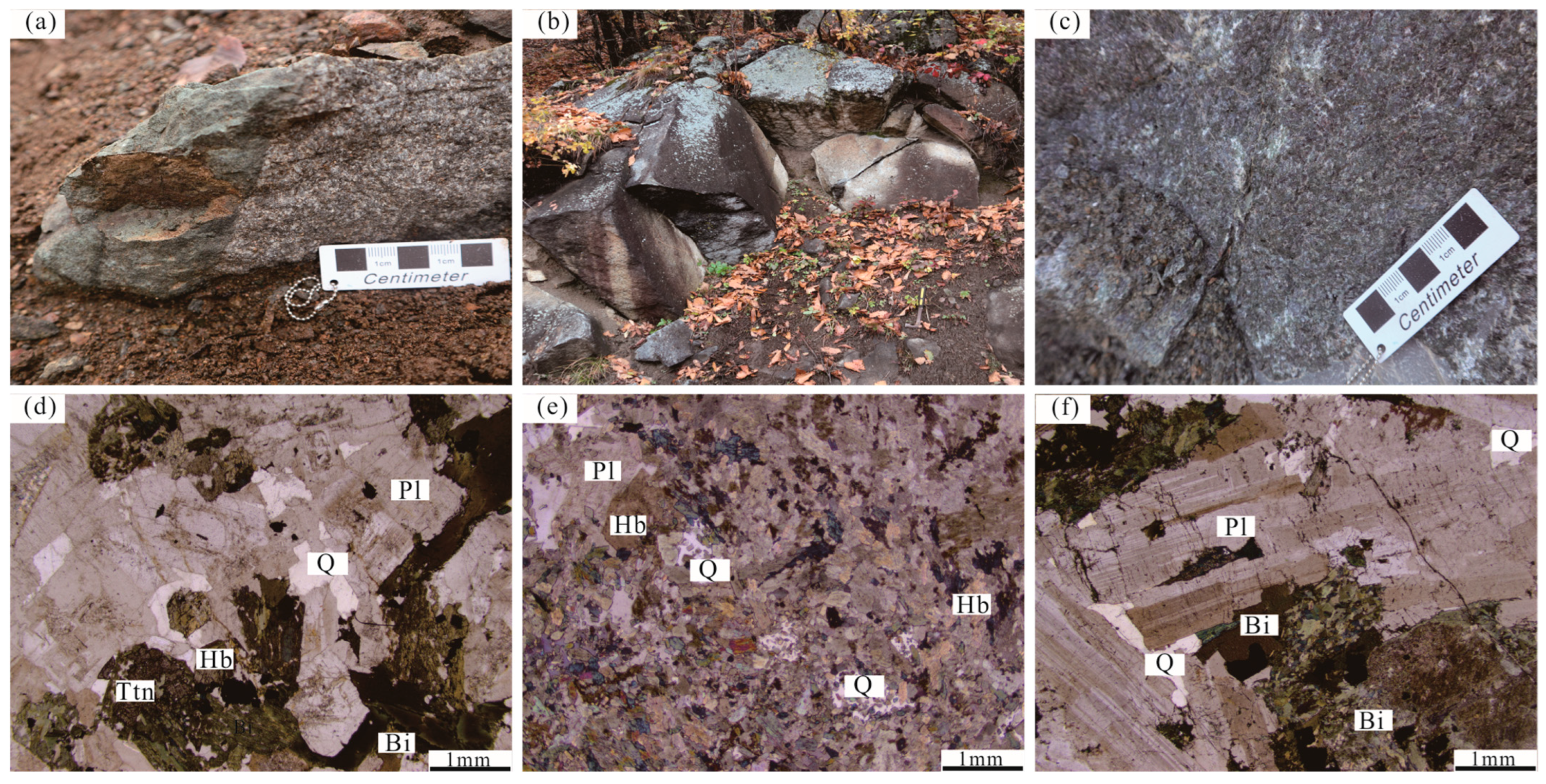
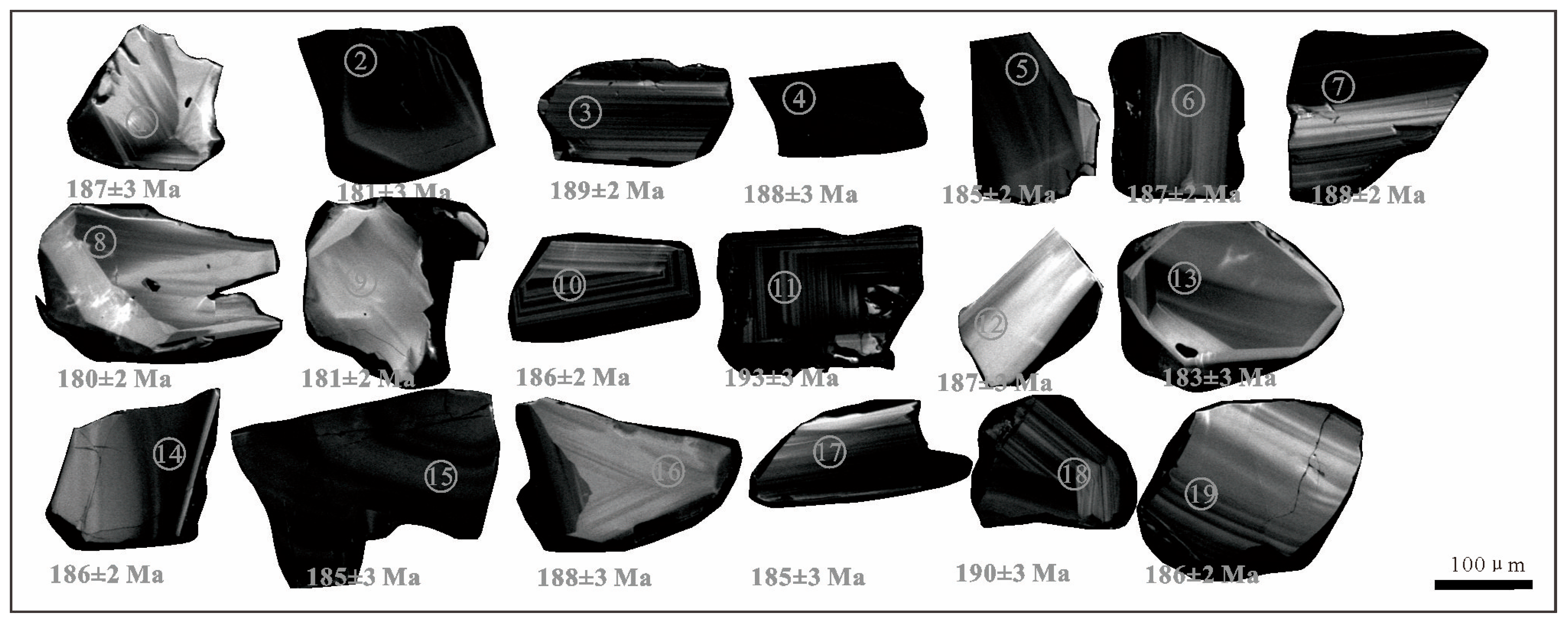
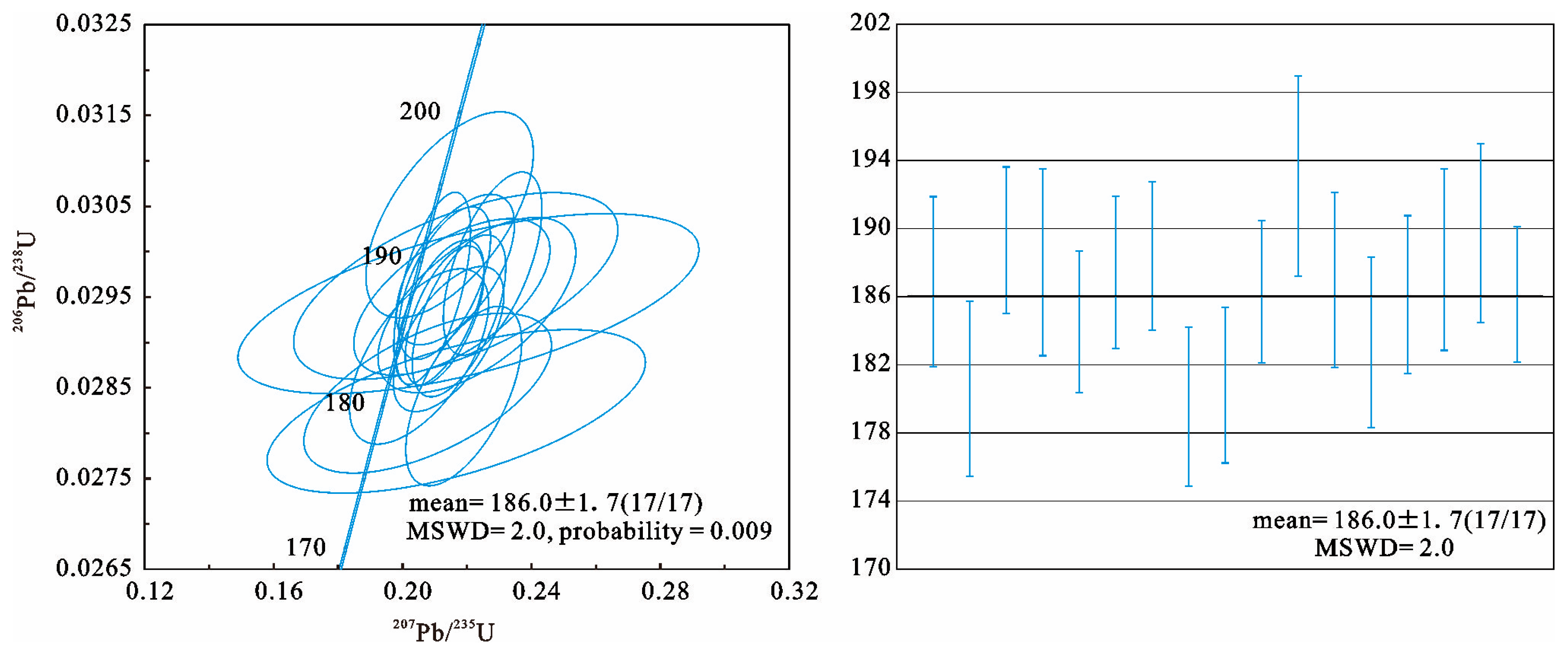
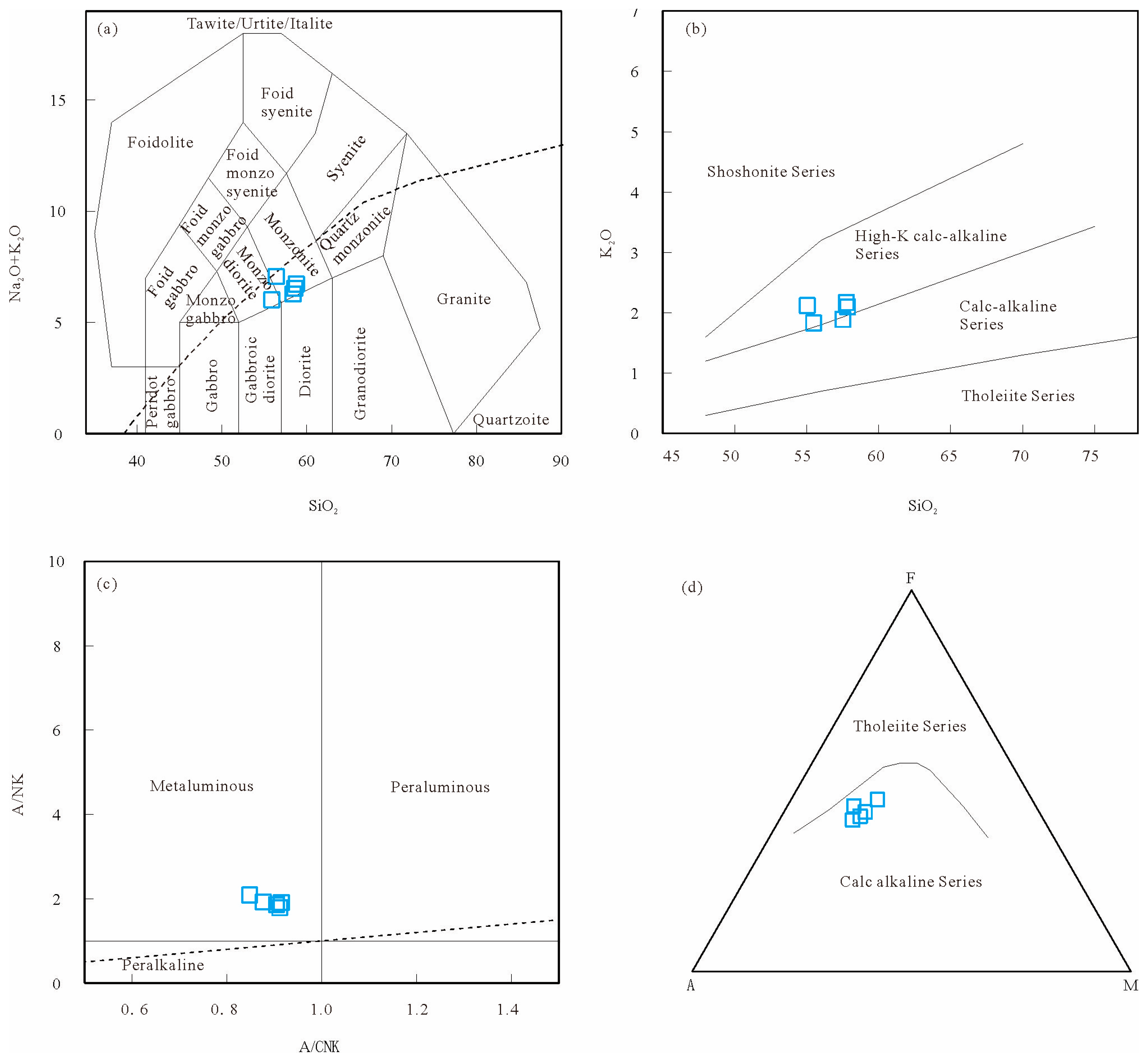
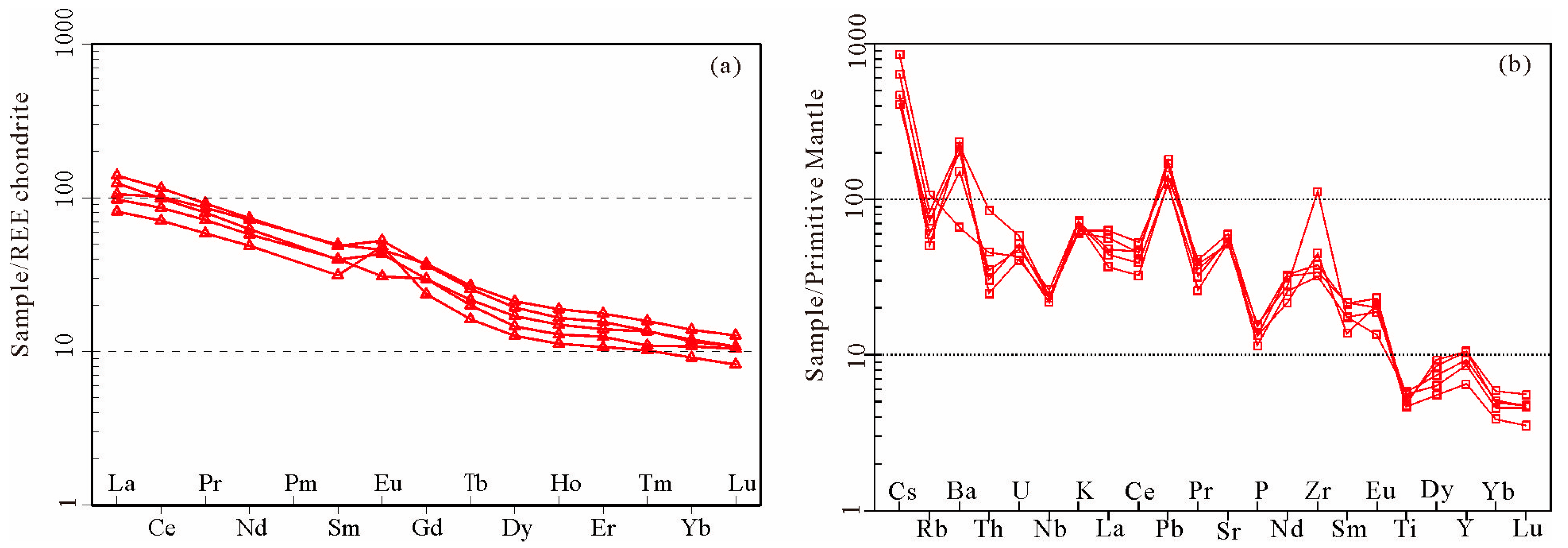
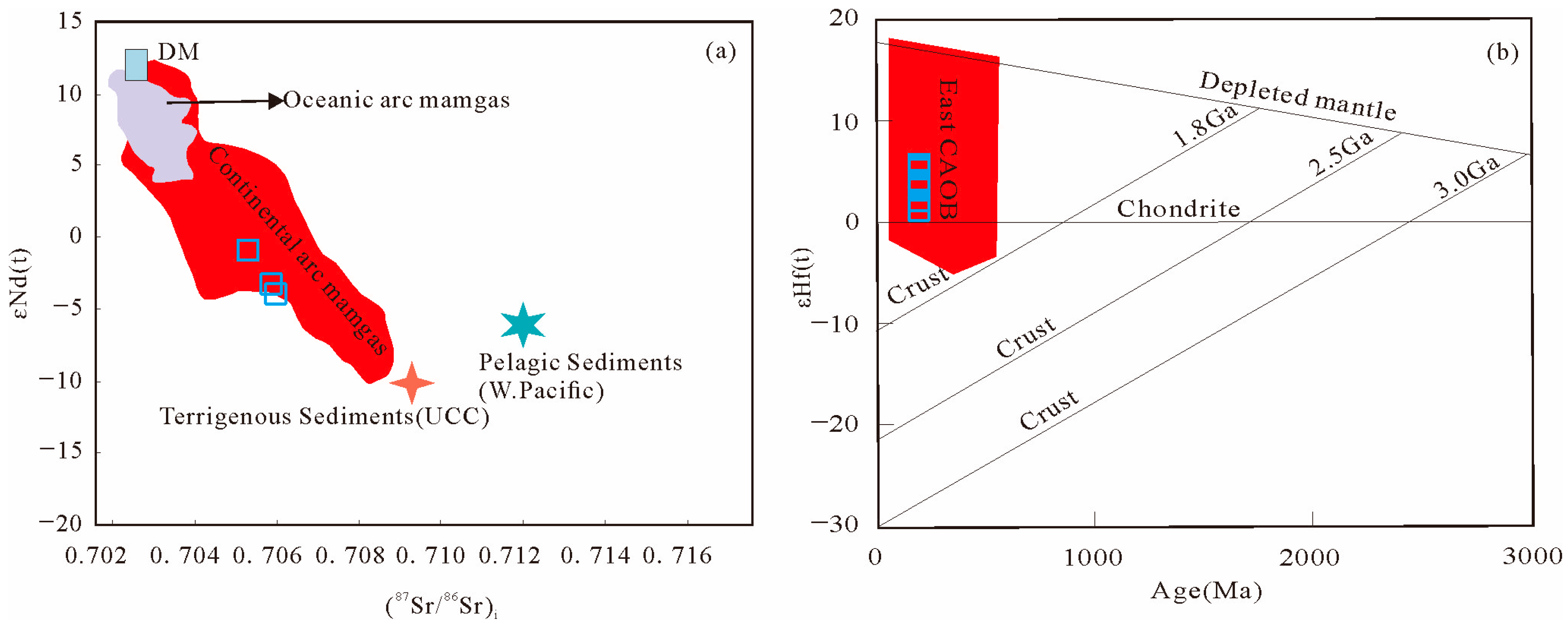
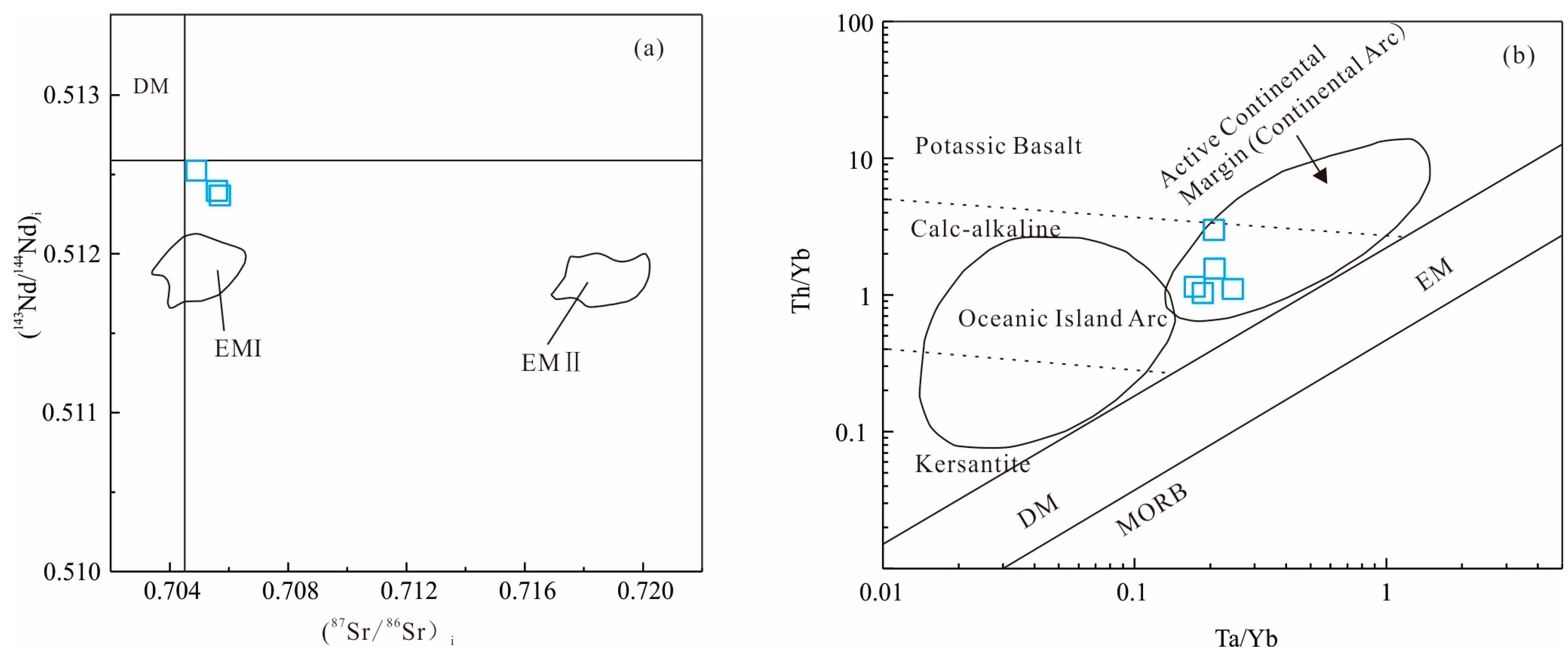

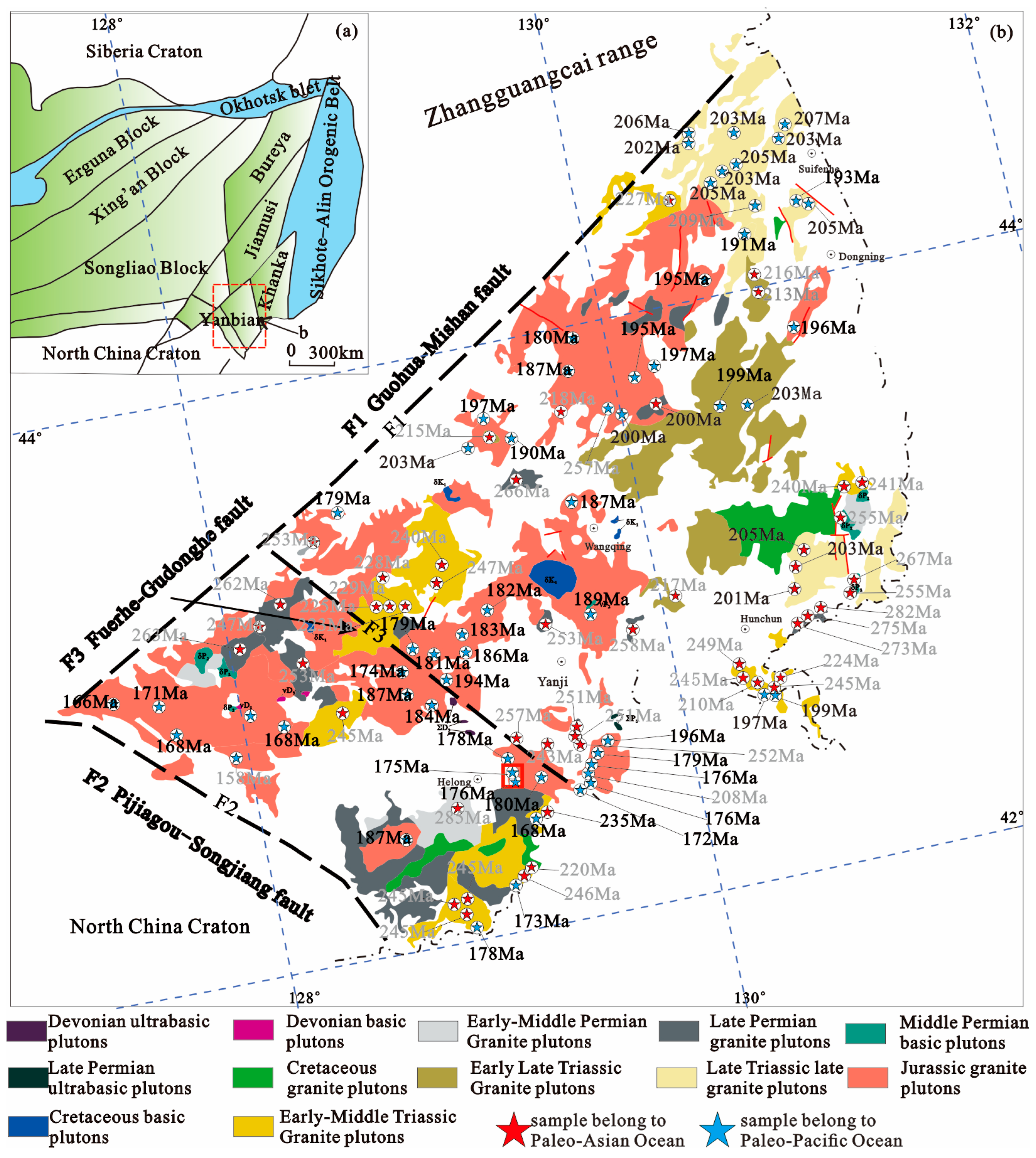
| Sample | U (ppm) | Th (ppm) | 206Pb/238U | 207Pb/235U | 207Pb/206Pb | 208Pb/232Th | 206Pb/238U Age (Ma) | 2σ |
|---|---|---|---|---|---|---|---|---|
| FD9_01 | 155.77 | 135.24 | 0.0294 | 0.2231 | 0.0550 | 0.0068 | 187 | 3 |
| FD9_02 | 399.19 | 251.34 | 0.0284 | 0.2190 | 0.0559 | 0.0067 | 181 | 3 |
| FD9_03 | 360.71 | 396.07 | 0.0298 | 0.2164 | 0.0527 | 0.0071 | 189 | 2 |
| FD9_04 | 949.41 | 1116.03 | 0.0296 | 0.2092 | 0.0513 | 0.0074 | 188 | 3 |
| FD9_05 | 362.58 | 357.51 | 0.0290 | 0.2143 | 0.0535 | 0.0074 | 185 | 2 |
| FD9_06 | 270.87 | 185.34 | 0.0295 | 0.2153 | 0.0529 | 0.0073 | 187 | 2 |
| FD9_07 | 630.65 | 857.87 | 0.0297 | 0.2131 | 0.0521 | 0.0076 | 188 | 2 |
| FD9_08 | 224.41 | 182.46 | 0.0282 | 0.2167 | 0.0556 | 0.0079 | 180 | 2 |
| FD9_09 | 161.71 | 152.45 | 0.0284 | 0.2078 | 0.0530 | 0.0076 | 181 | 2 |
| FD9_10 | 462.82 | 490.44 | 0.0293 | 0.2117 | 0.0524 | 0.0076 | 186 | 2 |
| FD9_11 | 496.28 | 543.81 | 0.0304 | 0.2146 | 0.0512 | 0.0079 | 193 | 3 |
| FD9_12 | 123.37 | 97.59 | 0.0294 | 0.2205 | 0.0543 | 0.0084 | 187 | 3 |
| FD9_13 | 284.77 | 220.63 | 0.0288 | 0.2051 | 0.0516 | 0.0074 | 183 | 3 |
| FD9_14 | 555.13 | 719.72 | 0.0293 | 0.2175 | 0.0539 | 0.0070 | 186 | 2 |
| FD9_15 | 387.51 | 380.38 | 0.0292 | 0.3064 | 0.0762 | 0.0085 | 185 | 3 |
| FD9_16 | 146.46 | 91.26 | 0.0296 | 0.2165 | 0.0530 | 0.0069 | 188 | 3 |
| FD9_17 | 266.48 | 84.45 | 0.0291 | 0.3094 | 0.0771 | 0.0085 | 185 | 3 |
| FD9_18 | 557.67 | 325.07 | 0.0299 | 0.2280 | 0.0554 | 0.0071 | 190 | 3 |
| FD9_19 | 549.46 | 748.55 | 0.0293 | 0.2131 | 0.0528 | 0.0069 | 186 | 2 |
| Sampe | FD1 | FD2-1 | FD2-3 | FD3-1 | FD9 | Sampe | FD1 | FD2-1 | FD2-3 | FD3-1 | FD9 |
|---|---|---|---|---|---|---|---|---|---|---|---|
| SiO2 | 57.76 | 57.51 | 57.84 | 55.48 | 55.04 | Nb | 18.6 | 16.96 | 16.47 | 16.53 | 15.5 |
| TiO2 | 1.03 | 1.09 | 1 | 1.21 | 1.25 | Cs | 3.68 | 5.05 | 3.71 | 3.23 | 6.76 |
| Al2O3 | 17.92 | 17.56 | 18.06 | 18.58 | 17.89 | Ba | 1053 | 1522 | 1624 | 1407 | 460.7 |
| Fe2O3 | 2.84 | 2.85 | 2.69 | 4.19 | 2.45 | La | 32.76 | 43.26 | 25.21 | 38.57 | 30.21 |
| FeO | 3.78 | 3.96 | 3.61 | 3.51 | 5.38 | Ce | 82.2 | 93.22 | 57.32 | 80.03 | 69.52 |
| MnO | 0.13 | 0.14 | 0.13 | 0.1 | 0.13 | Pr | 10.51 | 11.23 | 7.16 | 9.77 | 8.75 |
| MgO | 2.79 | 2.89 | 2.54 | 2.54 | 3.31 | Nd | 43.01 | 44.19 | 29.19 | 37.47 | 34.62 |
| CaO | 5.61 | 5.99 | 5.63 | 5.48 | 6.88 | Sm | 9.65 | 9.46 | 6.1 | 7.71 | 7.78 |
| Na2O | 4.27 | 4.3 | 4.52 | 5.12 | 3.81 | Eu | 3.36 | 3.87 | 3.55 | 3.16 | 2.26 |
| K2O | 2.17 | 1.89 | 2.1 | 1.83 | 2.12 | Gd | 9.64 | 9.41 | 6.11 | 7.66 | 7.67 |
| P2O5 | 0.29 | 0.33 | 0.29 | 0.34 | 0.25 | Tb | 1.27 | 1.21 | 0.77 | 0.947 | 1.03 |
| LOI | 1.24 | 1.46 | 1.34 | 1.28 | 1.07 | Dy | 6.82 | 6.22 | 4.07 | 4.68 | 5.46 |
| K2O + Na2O | 6.44 | 6.19 | 6.62 | 6.95 | 5.93 | Ho | 1.35 | 1.19 | 0.81 | 0.93 | 1.07 |
| A/CNK | 0.91 | 0.88 | 0.9 | 0.91 | 0.85 | Er | 3.7 | 3.27 | 2.24 | 2.61 | 2.93 |
| Li | 119.5 | 174.2 | 160 | 133.9 | 147.3 | Tm | 0.51 | 0.44 | 0.33 | 0.35 | 0.44 |
| Be | 10.9 | 9.37 | 9.47 | 13.16 | 12.5 | Yb | 2.89 | 2.42 | 1.91 | 2.25 | 2.5 |
| Sc | 32.02 | 54.02 | 20.26 | 31.73 | 40.67 | Lu | 0.41 | 0.346 | 0.26 | 0.34 | 0.35 |
| V | 431.8 | 408.7 | 371.9 | 391.6 | 630.9 | Hf | 6.64 | 6.60 | 7.35 | 18.93 | 6 |
| Cr | 79.2 | 69.97 | 67.95 | 81.52 | 65.68 | Ta | 0.54 | 0.5 | 0.47 | 0.39 | 0.52 |
| Co | 39.65 | 40.25 | 35.36 | 42.94 | 58.5 | Pb | 12.7 | 10.07 | 9.07 | 11.98 | 8.81 |
| Ni | 37.46 | 30.91 | 30.27 | 44.19 | 43.87 | Th | 2.97 | 7.22 | 2.1 | 2.57 | 3.88 |
| Cu | 146 | 84.42 | 85.08 | 133 | 133 | U | 1 | 1.22 | 0.85 | 1.08 | 0.9 |
| Zn | 267.2 | 260.7 | 274.9 | 304.3 | 307.2 | ∑REE | 208.09 | 229.72 | 145.01 | 196.49 | 174.58 |
| Ga | 43.07 | 44.54 | 40.44 | 49.56 | 46.16 | ∑LREE | 181.49 | 205.22 | 128.52 | 176.72 | 153.14 |
| As | 6.14 | 4.09 | 2.96 | 3.65 | 4.4 | ∑HREE | 26.6 | 24.5 | 16.49 | 19.78 | 21.44 |
| Rb | 38.01 | 52.35 | 31.88 | 45.85 | 67.97 | Eu/Eu * | 1.05 | 1.24 | 1.76 | 1.25 | 0.88 |
| Sr | 1086 | 1257 | 1118 | 1094 | 1174 | (La/Yb)N | 7.64 | 12.03 | 8.91 | 11.54 | 8.15 |
| Y | 48.01 | 47.52 | 29.45 | 38.87 | 41.89 | Mg # | 44 | 44 | 43 | 38 | 44 |
| Zr | 378.1 | 425.2 | 502 | 1257 | 359 |
| Sample | Rock Type | 87Rb/86Sr | 87Sr/86Sr | ±2σ | ISr | 143Nd/144Nd | ±2σ | εNd(0) | εNd(t) |
|---|---|---|---|---|---|---|---|---|---|
| FD1 | Quartz diorite | 0.2497 | 0.706384 | 0.000 009 | 0.7057 | 0.512366 | 0.000008 | −5.3 | −3.69 |
| FD2-1 | Quartz diorite | 0.2404 | 0.706279 | 0.000 008 | 0.7056 | 0.512396 | 0.000008 | −4.72 | −3.015 |
| FD9 | Quartz diorite | 0.2966 | 0.705733 | 0.000 009 | 0.7049 | 0.512523 | 0.000008 | −2.25 | −0.69 |
| No. | Age (Ma) | 176Yb/177Hf | 176Lu/177Hf | 176Hf/177Hf | 2σ | (176Hf/177Hf)i | εHf(0) | εHf(t) | TDM1(Ma) | TDM2(Ma) | fLu/Hf |
|---|---|---|---|---|---|---|---|---|---|---|---|
| FD9_1 | 187 | 0.0164 | 0.0004 | 0.282819 | 0.000030 | 0.282818 | 1.20 | 5.7 | 605 | 867 | −0.99 |
| FD9_2 | 181 | 0.0171 | 0.0004 | 0.282718 | 0.000023 | 0.282717 | −0.24 | 2.0 | 746 | 1100 | −0.99 |
| FD9_3 | 189 | 0.0710 | 0.0017 | 0.282761 | 0.000028 | 0.282755 | −0.85 | 3.5 | 710 | 1007 | −0.95 |
| FD9_4 | 188 | 0.0847 | 0.0020 | 0.282775 | 0.000026 | 0.282768 | −0.36 | 4.0 | 694 | 975 | −0.94 |
| FD9_5 | 185 | 0.0469 | 0.0011 | 0.282783 | 0.000022 | 0.282780 | −0.08 | 4.3 | 666 | 954 | −0.97 |
| FD9_6 | 187 | 0.0167 | 0.0004 | 0.282722 | 0.000022 | 0.282720 | −2.21 | 2.3 | 741 | 1088 | −0.99 |
| FD9_7 | 188 | 0.0908 | 0.0021 | 0.282823 | 0.000028 | 0.282816 | 1.34 | 5.7 | 627 | 871 | −0.94 |
| FD9_8 | 180 | 0.0316 | 0.0008 | 0.282719 | 0.000023 | 0.282716 | −0.24 | 2.0 | 751 | 1101 | −0.98 |
| FD9_9 | 181 | 0.0268 | 0.0006 | 0.282763 | 0.000021 | 0.282761 | −0.77 | 3.6 | 687 | 997 | −0.98 |
| FD9_10 | 186 | 0.0638 | 0.0014 | 0.282684 | 0.000023 | 0.282680 | −3.6 | 0.8 | 814 | 1181 | −0.96 |
Disclaimer/Publisher’s Note: The statements, opinions and data contained in all publications are solely those of the individual author(s) and contributor(s) and not of MDPI and/or the editor(s). MDPI and/or the editor(s) disclaim responsibility for any injury to people or property resulting from any ideas, methods, instructions or products referred to in the content. |
© 2025 by the authors. Licensee MDPI, Basel, Switzerland. This article is an open access article distributed under the terms and conditions of the Creative Commons Attribution (CC BY) license (https://creativecommons.org/licenses/by/4.0/).
Share and Cite
Song, J.; Zhu, Y.; Chen, X. Subduction Dynamics of the Paleo-Pacific Plate: New Constraints from Quartz Diorites in the Fudong Region. Minerals 2025, 15, 562. https://doi.org/10.3390/min15060562
Song J, Zhu Y, Chen X. Subduction Dynamics of the Paleo-Pacific Plate: New Constraints from Quartz Diorites in the Fudong Region. Minerals. 2025; 15(6):562. https://doi.org/10.3390/min15060562
Chicago/Turabian StyleSong, Jijie, Yidan Zhu, and Xiangzhong Chen. 2025. "Subduction Dynamics of the Paleo-Pacific Plate: New Constraints from Quartz Diorites in the Fudong Region" Minerals 15, no. 6: 562. https://doi.org/10.3390/min15060562
APA StyleSong, J., Zhu, Y., & Chen, X. (2025). Subduction Dynamics of the Paleo-Pacific Plate: New Constraints from Quartz Diorites in the Fudong Region. Minerals, 15(6), 562. https://doi.org/10.3390/min15060562






